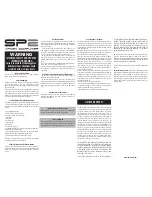
IM100CZ04-E4
8
7. LINEARIZING FUNCTION
SETTING
Linearizing switch changing
1.
First check the output characteristic type (A, N or B) engraved at
the end of the figure showing the rated output value on the rating
nameplate attached to the outer chamber of the pressure
sensor.
Example:
Rating
nameplate
PRESSURE SENSOR
TYPE
CZ-100P-HB-SNE
RKC INSTRUMENT INC. MADE IN JAPAN
PRESSURE RANGE
0 - 20
MPa
RATED OUTPUT
1.234A
mV/V at 150
C
G
No.
97J21020
DATE
9 710
2.
Next, check that the power to the PCT-300 output converter is
turned off, then remove the internal assembly from the case.
3.
Set the linearizing switch on the side of the internal assembly of
the PCT-300 to the position matching the output characteristic
type of the pressure sensor to be connected.
The gain selector switch or linearizing switch is optional.
The above figure shows all the optional switches to simplify
the explanation.
4.
House the internal assembly in the case.
This completes the setting.
8. TROUBLES AND CAUSE
Problem Possible
cause
Indication pointer
completely defects to the
left or right.
No indicator input circuit connected.
No 4-conductor shielded cable connected.
The defective connector used (standard or
water resistant connector).
Wires disconnected or shorted.
No internal sensor wiring connected.
The fiberglass coated cable immersed into
water or exposed to high temperature, resulting
in deteriorated insulation resistance.
No rated output set to the PCT-300
(different gain).
The double gain selector switch turned ON.
The strain gauge deteriorated due to exposure
to high temperature.
No zero adjuster adjusted.
Digital display over-scale
or underscale.
No pressure is indicated
under pressurized
condition.
Irregularly tapped hole for installing the
CZ-100P. (The sensor tip strongly contacting
with the tapped hole.)
The diaphragm deteriorated, deformed or
damaged.
*
Mechanical Lead pipe deformation by external
force.
Pointer or indication
fluctuates during relay
actuation.
No measures for relay spark killing taken.
No 4-conductor cable shield perfectly wired or
grounded.
The PCT-300 located near magnetically
operated relays.
Pressure indication is
fluctuated.
Value different from the sensor rated output set
to the rated output setter for the PCT-300.
The diaphragm deteriorated, deformed or
damaged.
*
The sensor exposed to hot or cold wind.
Some potential against the earth generated
(2-point grounding, etc.).
Normal operation was
performed, but no
reading was received
after a while or the
reading varied and was
unstable.
Imperfect connecter contact.
The lead pipe deformed by external force.
The diaphragm deteriorated, deformed or
damaged.
*
The fiberglass coated cable immersed into
water or exposed to high temperature, resulting
in deteriorated insulation resistance.
The sensor exposed to hot or cold wind.
The extruder now in unstable operation or
temperature rise.
Indication fluctuates from
the beginning.
The sensor tip forcibly tightened due to the
small tapped hole.
The lead pipe cover contacting with the barrel,
etc.
Resin leakage.
The sealed surface deformed or scratched.
Foreign material (carbide, etc.) attached on the
sealed surface.
Low sealed surface accuracy (parallelism, axis,
etc.).
No screw threaded down to the extreme end.
Tightened at less than appropriate torque or not
tightened.
No threads regularly
engaged (no screw
removed).
No screw threaded down to the extreme end.
Not threaded as conforming to the standard.
The screw with burrs used.
Tightened with excessive torque.
Tightened at temperature different from the
initial tightening temperature.
Foreign material attached on the threaded
section, or stained.
For taking measures, also refer to “
3.1 PRESSURE SENSOR
(CZ-100P)
.” The converter is described on a basis of the PCT-300.
For the cause of diaphragm deterioration, deformation or
damage, refer to the following “
* Main causes
.”
Continued on the next page.
To prevent electric shock and instrument failure,
always turn off the power supply before pulling out the
internal chassis.
To prevent injury or instrument failure, do not touch the
internal printed circuit board.
!
WARNING
Linearizing switch:
Set the switch to the position matching
the output characteristic type of the
pressure sensor.
Internal assembly of PCT-300
Upper
Lower
Front
Gain selector switch
1
2 ON
OFF
FILTER switch
A, N or B is engraved in this section.
For products other than corresponding to the linearizing
function, the output characteristic type (A, N or B) is not
engraved in this section.






























